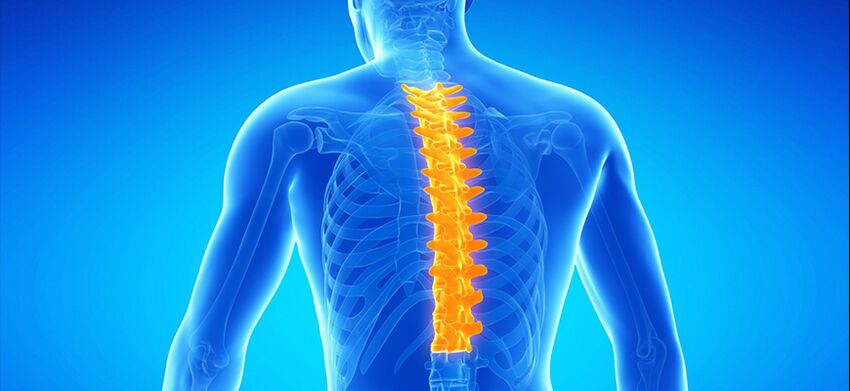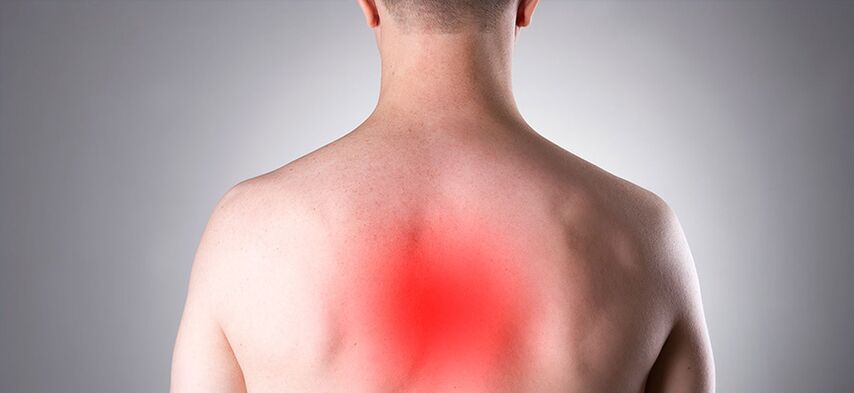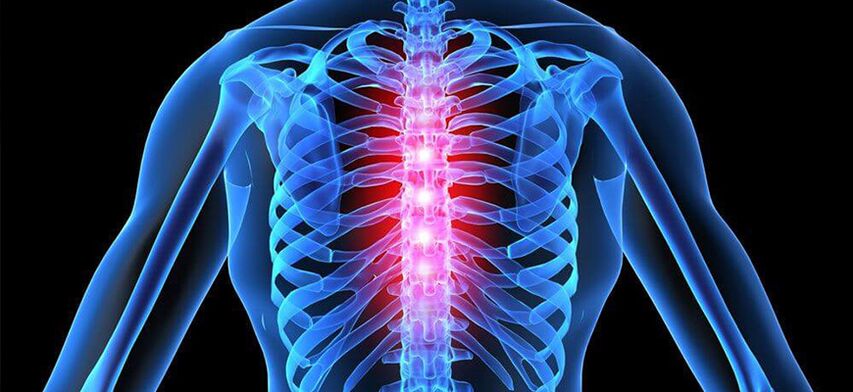
Thoracic osteochondrosis is a rather dangerous pathology, which is explained by the difficult diagnostic process. Therefore, it is often possible to identify the disease only at an advanced stage. Initially, osteochondrosis of the thoracic spine was considered a disease of the elderly, but recently there is a clear tendency towards significant "rejuvenation" of this disease, so it is important to know the main symptoms and treatment in order to improve the clinical pictureillness.
The complexity of the diagnosis is due to the fact that the vertebrae located in the chest area are the least susceptible to stress and injury. However, limited mobility is not a guarantee of safety, so the appearance of pathologies in this department is also very common. As statistics show, this disease is not directly related to the aging process and gender.

Specificity of the disease
This disease is characterized by pathological processes that lead to negative changes in the structure of tissues. This can destroy the fiber ring of the intervertebral disc itself and, as a result, protrude the nucleus pulposus. This condition is dangerous because of the risk of compression of the spinal cord and further obstruction of the person.
The progression of the disease in childhood can lead to premature aging of the musculoskeletal system before it finally develops. For this reason, it is extremely important to diagnose the pathology in the early stages, when the destruction of the vertebrae and adjacent tissues has not yet occurred.
Clinical symptoms
This disease manifests itself very differently depending on the stage. Therefore, we will highlight the general symptoms of osteochondrosis of the thoracic spine:
- Pains. It can occur not only when performing actions, but also when staying in static positions for a long time.
- Stiffness of movement that prevents the body from rotating freely.
- Shortness of breath caused by feeling too much pressure in the middle of the back.
- Problems with the functioning of the gastrointestinal tract and other internal organs.
Very often the disease manifests itself as painful sensations on the left side of the chest, which can be interpreted as a symptomatology of heart disease. This complicates the diagnosis, but the specialist evaluates the entirety of all the patient's complaints, which makes it possible to correctly interpret all the symptoms present.
If you know what symptoms are osteochondrosis of the thoracic spine, you can get qualified help immediately. We encourage you to pay more attention to the signals your body is giving.

When diagnosing it, it is important to know how osteochondrosis of the chest region manifests itself, since this disease is insidious and therefore it is easy to confuse it with other diseases. Based on the type of pain, the main types of osteochondrosis of the thoracic spine can be distinguished. One condition is characterized by persistent pain in the damaged area of the spine, and the second is characterized by the occurrence of acute attacks that literally hold down a person's movements and make their breathing functions difficult.
Causes of the disease
The following causes of osteochondrosis of the thoracic spine can be distinguished:
- Pathological processes that negatively affect the structure of the intervertebral discs. In particular, there is a certain genetic predisposition to this disease.
- Lack of activity related to performing their work functions and the specifics of leisure activities.
- Scoliosis, which is the cause of increased stress on certain parts of the spine.
- Mechanical damage to the chest.
- Weight training related to lifting large loads.
- Regular stressful situations.
- Hypothermia of the body.
- Lack of calcium.
- Hormonal disorders.
Classification of the disease
Intervertebral osteochondrosis of the thoracic spine develops in stages, each of which is characterized by its own negative manifestations:
- First degree. The initial stage of osteochondrosis of the chest region is characterized by a condition in which there is a loss of moisture through the intervertebral disc. Elasticity decreases, painful sensations of low intensity appear, which completely disappear when a person takes a comfortable posture.
- Second degree. The disc continues to lose moisture. This makes it smaller, cracks appear, some of them are quite deep. The muscle corset tries to adapt and tries to maintain the stability of the spine, which leads to cramps and severe pain in the back, chest and limbs.
- Third degree. At this stage, the nucleus pulposus breaks through to the outside. At its core, it is an intervertebral hernia in which the pain persists throughout the day. A person is forced to change the type of activity to one where the discomfort is not as intense.
- Fourth degree. Extensive osteochondrosis of the thoracic spine is dangerous because serious restructuring of all tissues begins at the site of damage. There is a natural replacement of the tissue of the annulus fibrosus by the bone, which leads to a strong stiffness of movement. The appearance of osteophytes and deformities of the spine are also observed.
Period of exacerbation

The manifestation of osteochondrosis of the chest region at the stage of exacerbation is characterized by the appearance of paroxysmal pain, which is extremely difficult to relieve with improvised means. Self-medication at this stage is unacceptable, so urgently consult a doctor or call emergency help to relieve the pain.
Only a neurologist can correctly interpret your symptoms and prescribe an appropriate follow-up examination and treatment. During an exacerbation, it is extremely important to alleviate the patient's condition.
A number of factors can cause the disease to worsen, including stressful situations, hypothermia, and activities associated with intense stress. In this condition, a significant deterioration in the patient's well-being is observed, breathing can be difficult and mobility restricted. In some cases, hospitalization may be required.
Basic diagnostic methods
Signs of osteochondrosis of the thoracic spine are the appearance of pain of various localization, stiffness of movement, as well as breathing difficulties. The complexity of the diagnosis lies in the fact that a wide variety of diseases of different types fit this description. In particular, there is such a concept - the "gastrological syndrome", which is characterized by the appearance of pain in the upper abdomen, which can be misinterpreted as manifestations of gastritis or other diseases of the gastrointestinal tract.
Only modern diagnostic methods allow an accurate diagnosis, on the basis of which the neurologist prescribes the appropriate therapy. Everything begins with a detailed discussion with the patient, clarification of existing complaints and accompanying illnesses.
After taking the anamnesis, the doctor goes directly to the examination himself with special tests. Then the patient has to undergo the necessary laboratory tests as well as X-ray and MRI examinations. Magnetic resonance imaging allows you to examine the condition of the spine in more detail, identify existing pathologies, as well as the size and location of the hernia (if any).
How does the treatment process work?
Knowing what to do with osteochondrosis of the chest region is extremely important. After confirming the diagnosis, the doctor prescribes an individual therapy regimen for the patient. It is necessary to take into account the age and presence of concomitant diseases, as well as allergies to certain drugs.
In the first phase, treatment is carried out with various drugs: nonsteroidal anti-inflammatory drugs, analgesics and antispasmodics.
The main goal at this stage is to alleviate the patient's condition, reduce pain syndrome and muscle spasms. In particularly severe cases, when immediate relief of acute pain is required, analgesic blocks are used.
Topical agents in the form of ointments and gels can also be used, but their effectiveness is somewhat less due to the difficulty of delivering agents to the lesions.
In general, the treatment of thoracic spine osteochondrosis is an integrated approach that combines the use of several methods at the same time. Only such a therapy cannot lead to a one-off positive result, but to an improvement in the clinical picture over time.
physical therapy
Physiotherapy is performed after pain relief. It is extremely important to make all movements slowly and avoid sudden movements to prevent the condition from worsening.
Just remember to stop immediately and see a doctor if the exercise causes pain.
Massage procedure

Muscle cramps, hypertension, pain - this is how osteochondrosis of the thoracic spine manifests itself. Massage, which should be performed by a qualified professional, can be used to get rid of these symptoms. These procedures can be used not only for therapeutic purposes but also as a good preventive measure.
prophylaxis
The consequences of osteochondrosis of the thoracic spine will not be as severe if you strictly follow certain medical recommendations. If a specialist has prescribed bed rest for you, then in no case should you ignore it, otherwise your condition may worsen. A person should limit himself to physical activity, so he must refuse to go to the gym and work with weights.
An important part of primary prevention is the timely identification of people during medical examinations who show the first signs of osteochondrosis of the thoracic spine. Another, no less important point is proper nutrition, which means that certain foods are avoided. It is necessary to limit the use of salt, so it is necessary to remove from the diet smoked meat, various hot spices and cucumbers.
It is very important to use drugs with a chondroprotective effect, which slow the progression of osteochondrosis of the thoracic spine, nourish and improve metabolic processes in cartilage tissue.
diploma
Thoracic osteochondrosis of the spine can be treatable. In order for this to be possible, you need to strictly follow the recommendations of the attending physician and adhere to the established regimen of therapy. Initial thoracic osteochondrosis is best treated, so it is extremely important to be attentive to your body and respond to the slightest symptoms of the disease.
To avoid a possible relapse, you need to follow preventive measures and monitor your posture, which is especially important when you are sedentary. Consult only qualified doctors, because only they can prescribe a competent treatment regimen and further recovery.





































